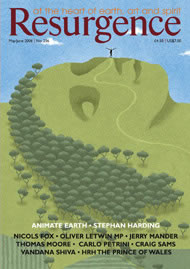THIS BOOK IS the outcome of a programme entitled ‘Awake: Art, Buddhism, and the Dimensions of Consciousness’, which took place in 2001–3. The programme consisted of multiple events involving exhibitions, performances and public forums. Arts professionals, artists, critics and Buddhists were brought together to investigate the impact of Buddhist perspectives on artistic and museum practices in the US.
Religion and art have not been good bedfellows during the age of modernity. Now, in these dangerous and terror-stricken times, religion has once again been transformed into a war-making tool – incompatible with life itself. In such circumstances, how do we get past our embarrassment about God? How can we even begin to talk about art in the same breath as religion, or try to suggest that they can come together again?
Let me say right away that Buddha Mind in Contemporary Art does not precisely address these questions. What it offers is a series of vital imperatives and specific examples powerful enough to weaken the current philosophical base of artistic practice. The mainstream dictates that art itself is the primary theme, and ironic, self-aware surfaces are the method. Within that paradigm, questions of ‘right action’ and ethical behaviour flounder against a backdrop of silence. In the art world, a certain stigma remains attached to artists who work in communities. Especially if their art is oriented towards benefiting others, they are often pegged as community activists rather than being granted status as ‘real’ artists. The competitive art world may think of itself as a community, but it rewards personal expression, individual achievement, and wall-to-wall networking. Helping people is not considered part of the agenda, unless it is related to career.
In truth, there’s nothing really new about practices that go against the cultural norm of art for art’s sake: they have been around for quite some time. But by consciously enlisting Buddhism as a road map for stepping beyond the mechanism, positivism, materialism and secularism of Western modernity, the book’s editors intend a conscious dissociation from ordinary mainstream awareness, and they successfully nudge art away from its own canons and borders.
Buddhism is a sublime vehicle for teaching us certain truths; for refining awareness, training the mind and cultivating the wisdom of altruism and compassion. It diminishes the power of culturally agreed-upon ego-striving. As a model for artistic practice, Buddhism opens the door to non-duality.
If Buddhism teaches us to relate to the world with openness, acceptance, and generosity, former museum curator Marcia Tucker wants to know, “Could it teach us to relate to art in the same way?” By way of an answer, consider artist Ann Hamilton’s statement: “It is very difficult for us from a Western philosophical tradition to see reality as made up of something that is not, in some way, an object … for us to recognise presence, absence, or emptiness as something.” Buddhism wrests us from the grip of art as a set of static, discrete objects – of art as wilfully elite things – in favour of fluctuations of energy and improvisational processes.
Many artists whose work is discussed in this book do not necessarily consider themselves Buddhists. In one of the interviews, performance artist Marina Abramovic describes how, in ‘Nightsea Crossing-Conjunction’ she and her artistic collaborator, Ulay, invited a Tibetan lama and an Aboriginal medicine man to sit around a table, motionless, looking at each other for four days, four hours each day. Later on, when she and Ulay extended the piece, they both sat together completely silent and motionless, for seven hours a day. Nothing was happening. “When you do nothing, it’s amazing what’s happening,” Abramovic comments. “You charge the space with another type of energy.”
In the process of long periods of motionless sitting, high states of meditation may be attained. Experiencing such states through her art was the provocation that eventually led Abramovic to become actively interested in Buddhism – rather than the other way around.
One artist, Ernesto Pujol, took up a hermetic life of poverty and celibacy in a small Trappist monastery in South Carolina after finishing art school – until he left four years later to begin a different life as an artist in New York City. His monastic training, however, had carved away his ego-driven self, so he chose to begin his artistic work with homeless men in a homeless shelter, where he could function with humility and true social immersion.
“Within global capitalism, humility ceased to be a value long ago,” says Pujol. “The humble person is considered a loser, and kindness is tragically mistaken for weakness.” Contemporary artists, Pujol feels, need to reacquaint themselves with humility in order to recover their historical social relevancy. “Ideally, the right practice of art should produce as many saints as the practice of spirituality,” he says, in what may be my favourite unauthorised comment in the book, because of its explosive velocity against the cultural grain.
Does the book work? Some of the art shown in the illustrations is not well explained in the text, and remains almost incomprehensible without prior knowledge of the artist’s work, and several of the essays are more like inspired stabs in the dark than assessments of a coherent paradigm with real synthesising reach. But it doesn’t matter. We need a new mind. We need a new society. The task of ‘re-enchanting’ our whole culture is a crucial task of our time. Anything that throws spirituality and reverence into high relief and cleanses the palette of intolerance is nothing short of marvellous. Culture is redefined by the creation of new narratives. Buddha Mind is like a little life raft set sail into the wind.
Suzi Gablik is author of Living the Magical Life.







